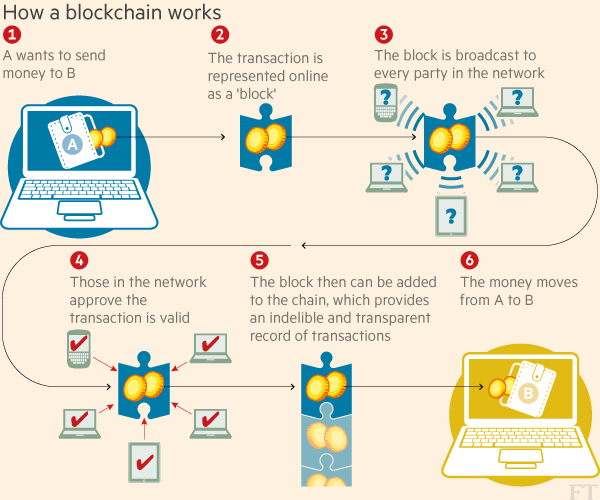#Introduction
- Banks have made the exchange of currency their business. But the digital age has ushered in a new way of banking, disrupting the institutions that have controlled the industry for hundreds of years.
- It’s the internet of banking, developed by private citizens for private citizens.While innovation in the industry is most commonly linked to Bitcoin, a cryptocurrency, it’s the underlying technology, blockchain, that might produce the biggest waves.“Blockchain presents an opportunity to bring disparate things together and allow secure, nonrefutable records of transactions to be done anywhere you need them to be done — quickly, securely and with little chance of fraud,” said Andrew Dare, architect of financial services innovation at Hewlett-Packard Enterprise in Halifax, U.K. “Therein lies the true value of the technology.”
- Many people know it as the technology behind Bitcoin, but blockchain’s potential uses extend far beyond digital currencies. Its admirers include Bill Gates and Richard Branson, and banks and insurers are falling over one another to be the first to work out how to use it.
- Currently, most people use a trusted middleman such as a bank to make a transaction. But blockchain allows consumers and suppliers to connect directly, removing the need for a third party.Using cryptography to keep exchanges secure, blockchain provides a decentralized database, or “digital ledger”, of transactions that everyone on the network can see. This network is essentially a chain of computers that must all approve an exchange before it can be verified and recorded.
- The technology can work for almost every type of transaction involving value, including money, goods and property. Its potential uses are almost limitless: from collecting taxes to enabling migrants to send money back to family in countries where banking is difficult. Blockchain could also help to reduce fraud because every transaction would be recorded and distributed on a public ledger for anyone to see.
- It is invented by an unidentified programmer, or group of programmers, under the name of Satoshi Nakamoto. Bitcoin was introduced on 31 October 2008 to a cryptography mailing list, and released as open-source software in 2009. The blockchain format was first used for bitcoin, as a solution to the problem of making a database both secure and not requiring a trusted administrator.
- In traditional fiat money systems, governments simply print more money when they need to. But in bitcoin, money isn’t printed at all – it is discovered. Computers around the world ‘mine’ for coins by competing with each other.
- People are sending bitcoins to each other over the bitcoin network all the time, but unless someone keeps a record of all these transactions, no-one would be able to keep track of who had paid what. The bitcoin network deals with this by collecting all of the transactions made during a set period into a list, called a block. It’s the miners’ job to confirm those transactions, and write them into a general ledger.
- We aim at browsing through the documentations related to BlockChain as much as possible and learn its working.
- We are planning to explore how transaction occurs between 2 Bitcoin accounts by referring and reading different blogs and videos. We plan to create 2 BitCoin accounts and store a minimum amount in these accounts. We plan to do this only after ensuring that this is safe.
- We aim at learning about BitCoin mining in detail and its role in retaining the BlockChain.
- We are also planning to conduct a survey and get an idea about the percentage people that are aware about BitCoins, Blockchain and other such related topics. We plan to send this survey to our classmates and if the college permits, send this survey to other classes too.
- We discovered the procedure of buying and using bitcoins. We found that there are many platforms where one can buy bitcoins such as Coinbase, Zebpay, Unicoin, localBitcoins etc. One can buy bitcoins from either exchanges, or directly from other people via marketplaces.
- One can pay for them in a variety of ways, ranging from hard cash to credit and debit cards to wire transfers, or even with other cryptocurrencies, depending on who you are buying them from and where you live. In India, Zebpay is preferred.
- Coinbase is the most popular bitcoin client. The first step is to sign up for a Coinbase account. This will give you a secure place to store your bitcoin, and easy payment methods to convert your local currency into or out of bitcoin. After you sign up, connect your bank account. You'll need to complete some verification steps before you can use the account. Once the verification steps are complete, you can make a purchase.
- When a block of transactions is created, miners put it through a process. They take the information in the block, and apply a mathematical formula to it, turning it into something else. That something else is a far shorter, seemingly random sequence of letters and numbers known as a hash. This hash is stored along with the block, at the end of the blockchain at that point in time.
